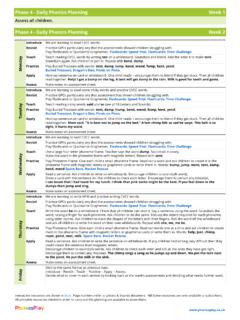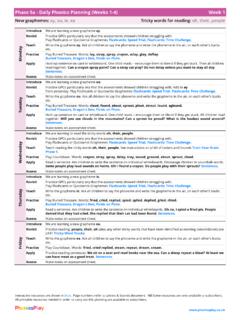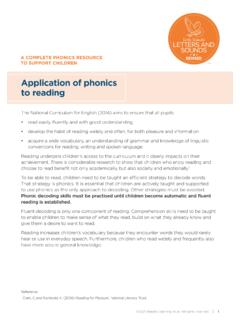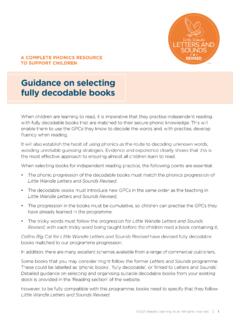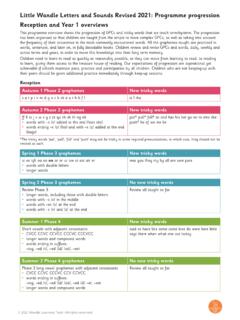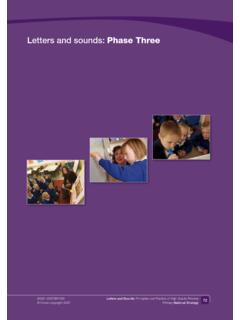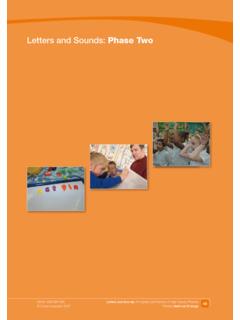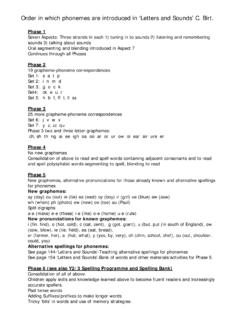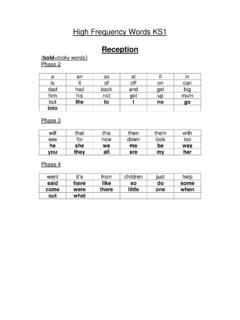Transcription of Phase 2 - Daily Phonics Planning Week 2
1 Interactive resources are shown in blue. Page numbers refer to Letters & Sounds document. NB Some resources are only available to subscribers. All printable resources needed in order to carry out this Planning are available to subscribers. Phase 2 - Daily Phonics Planning Week 1 Assess all children. Phase 2 - Daily Phonics Planning Week 2 Set 1: s, a, t, p Monday Introduce We are learning a new letter s. Revisit Revision from Phase 1. Look at sets of 3 pictures 2 that rhyme and 1 that doesn t. Ask children to find the odd one out. hat, cat, bus / bin, bell, pin / bun, lock, sock / fan, pan, pig. Cake Bake ( Phase 1) Teach Introduce the letter s - see three part example session for teaching a letter p51. Practise The children practise writing the letter s with a finger in the air, on the carpet, on the back of another child, on a whiteboard, on paper with a pencil.
2 See p52. Apply Play Silly Soup (Revision of Phase 1) see p34. Ask children to find the pictures that start with s and put them into the saucepan. Assess Make notes on assessment sheet. Who can recognise the sound ? Who can write the letter ? Tuesday Introduce We are learning a new letter a. Revisit Revision from Phase 1. Play Name Play see p34 in Letters and Sounds. Children make up alliterative sentences including their name Josh jumps and jiggles. Teach Introduce the letter a - see three part example session for teaching a letter p51. Practise The children practise writing the letter a with a finger in the air, on the carpet, on the back of another child. See p52. Apply Revision of Phase 1. Look at pictures of objects that start with s and a. Write s on a small box (a whiteboard with a box drawn on it will do).
3 Write a on another box. Children take it in turns to choose a picture card, say what the picture is of, what phoneme it starts with and place it in the correct box. Assess Make notes on assessment sheet. Who can recognise the sound ? Who can write the letter ? Wednesday Introduce We are learning a new letter t. Revisit Play Silly Soup (Revision of Phase 1) see p34. Ask children to find the pictures that start with t and put them into the saucepan. Teach Introduce the letter t - see three part example session for teaching a letter p51. Practise The children practise writing the letter t with a finger in the air, on the carpet, on the back of another child. See p52. Apply Practise oral blending. Play What s Missing (p56). Put picture cards on the table - cat, pin, map, dog, pig, mug.
4 sound talk a word Ask children to repeat the word in sound talk then blend together to make the word. Children look to see if that item is there. Include the words shown in the pictures and some other items that are missing. dog, pig, ship, map, pin, rat, cat, hat, mug. Assess Make notes on assessment sheet. Who can recognise the sound ? Who can write the letter ? Thursday Introduce We are learning a new letter p. Revisit Play Flashcards with the letters s a t. See p52. Show a flashcard, children say the phoneme. Repeat, increasing speed. Flashcards: Speed Trial, Flashcards: Time Challenge Teach Introduce the letter p - see three part example session for teaching a letter p51. Practise The children practise writing the letter p with a finger in the air, on the carpet, on the back of another child.
5 See p52. Apply Practise oral segmentation play the picnic game see p57. A toy (who only understands soundtalk) is choosing what to put in a picnic basket. Tell the children the name of the item jam and ask them to say the word then soundtalk it for the toy. Use a mixture of sensible and crazy items. Assess Make notes on assessment sheet. Who can recognise the sound ? Who can write the letter ? Friday Introduce We will practise all the letters we have learned and practise blending and segmenting. Revisit Put an assortment of magnetic letters/phonix cubes or grapheme cards down. Say a phoneme (s a t p) and ask children to find the letter . Muddle the letters up again and repeat. Who can get to the letter first. Teach Repeat Say it and Write it from p52 for each of the four letters learned so far.
6 Talk through the formation of the letter whilst following the shape with your finger. Encourage the children to join in with talking through the formation and making the shape with their finger in the air then try writing the letter on whiteboards or paper. Practise Children write each letter (s a t p) on a post it note. Apply Find items around the room that begin with each letter . Label with the post it notes. Assess Make notes on assessment sheet. Can they recognise the sounds? Can they write letters? Interactive resources are shown in blue. Page numbers refer to Letters & Sounds document. NB Some resources are only available to subscribers. All printable resources needed in order to carry out this Planning are available to subscribers. Phase 2 - Daily Phonics Planning Week 3 Set 2: i, n, m, d Reading High Frequency words : is, it, in, at Monday Introduce We are learning a new letter i.
7 Revisit Play Quickwrite Letters with the letters s a t p. See p55. Say a phoneme with actions. Children write the grapheme on a whiteboard. Flashcards: Speed Trial. Teach Introduce the letter i - see three part example session for teaching a letter p51. Practise The children practise writing the letter i with a finger in the air, on the carpet, on the back of another child. See p52. Apply Practise writing the letters learned so far using a range of writing implements on different sizes and colours of paper. Assess Make notes on assessment sheet. Who can recognise the sound ? Who can write the letter ? Tuesday Introduce We are learning to blend words for reading. Revisit Play Flashcards with the letters s a t p i, see p 52/53. Show a flashcard children say the sound . Repeat and build up speed.
8 Flashcards: Speed Trial, Flashcards: Time Challenge. Teach Play sound Buttons to teach blending for reading, see p58. Write a word and draw a sound button underneath each sound in the word. Pretend to press each button as you make the sound , then blend all the sounds together to say the word. Ask children to repeat. Use any of these words : at, it, is, sat, pat, tap, sit, tip, pip, sip. Practise Play Buried Treasure using the words : sat, pat, tas, si, is, ti, it, pip. Show children a real or made up word written on a coin. Ask a child to soundtalk the word then blend it together. Ask all children to repeat the soundtalking and the blending. Ask children to decide whether the word is real (put it in the treasure chest) or fake (put it in the bin). Buried Treasure, Dragons Den, Picnic on Pluto.
9 Apply Hold up word cards that give instructions in turn. Children take it in turns to sound talk the word and then act out following the instruction. Sit, tap, sip, pat Assess Make notes on assessment sheet. Can the children recognise the letters learned so far? Can they blend the sounds together? Wednesday Introduce We are learning a new letter n and learning to blend to read words . Revisit Play Flashcards with the letters s a t p i. Teach Introduce the letter n - see three part example session for teaching a letter p51. Practise Play sound buttons (see p58) using any of these words : an, in, nip, pan, pin, tin, tan, nap, nit. Apply Spread out word and picture cards for pat, tap, pip, pin. Model taking a word card, sound talking the word and blending it. Ask children to match the card to the picture.
10 Repeat with the other word cards. Assess Make notes on assessment sheet. Can the children recognise the letters learned so far? Can they blend the sounds together? Thursday Introduce We are learning a new letter m and learning to blend to read words . Revisit Revise oral blending by playing Georgie s Gym see p55. Explain that Georgie (a soft toy) will give exercise instructions but that she only talks in soundtalk. For example, if Georgie says stand u-p ask the children to repeat the soundtalking, blend and follow the instructions, put your hands on your t-oe-s. P-a-t your t-u-m etc. Teach Introduce the letter m - see three part example session for teaching a letter , p51. Practise Play sound Buttons (see p58) using any of these words : am, man, mat, map, Sam, Tim, an, in, nip, pan, pin, tin, tan, nap, nit.

